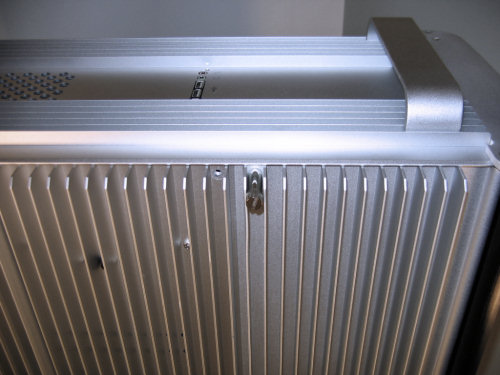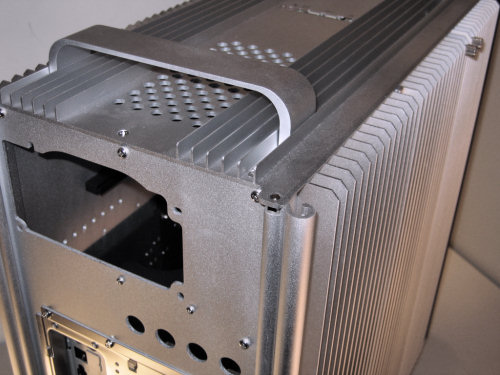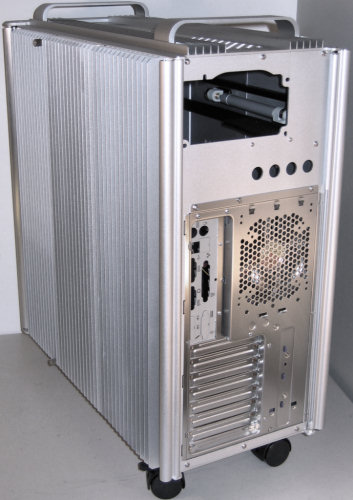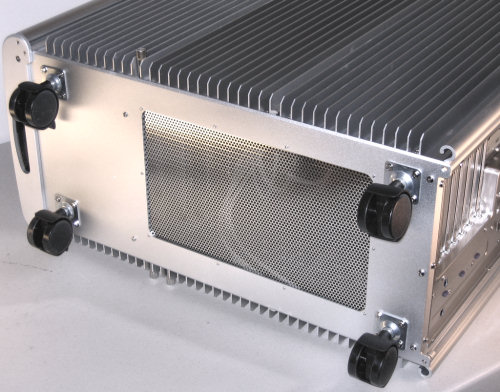Clash of the Titans - TT Tai Chi vs. CM Stacker 830
by Joshua Buss on February 23, 2006 12:05 AM EST- Posted in
- Cases/Cooling/PSUs
Thermaltake Tai Chi (cont’d)
An inch and a half long extended thumbscrews hold each part of the hinged door at the top and bottom, and since it's a double-hinge design on the left side, a total of four thumbscrews can be used – however, the front flap overlaps the main door and thus a single screw on the front panel at the top or bottom is the minimum needed to hold the side shut.
Moving further backwards, we can take a close look at the rear handle and rear backing plate. The thickness of the aluminum panels is very evident in this picture, as is the fact that the case can be completely separated into component parts and screws.
At first, this feature might seem rather unimportant, but the more that one thinks about it, the more obvious it is that to the enthusiast and even casual modder, this component nature is exceptionally valuable. For instance, the default ports visible in the back plate here for water cooling are 3/8” in diameter, which is fine for 3/8” O/D water tubing. However, 3/8” ID (inner diameter) tubing is pretty popular too, and without the ability to remove this plate from the rest of the case precisely enlarging these holes to the proper size would be much more difficult.
The over-sized rounded edges on the back resemble the look of the corners at the front of the case, but more importantly, they simply provide protection from the rest of the back of the computer and the rear-most fins of the side panels. Notice also how the rear of the case and the back of the motherboard area are completely separate, so that with a different motherboard standard such as BTX, all one needs to do is replace this back plate.
Turning the case on its side to inspect the bottom reveals that just as much attention to detail has been paid to it as the rest of the case. First off, notice that the heavy-duty casters are removable, should one decide they really would have the case take up less vertical space or simply have replacements that they'd rather use instead. When raised, however, the case benefits from the additional airflow capabilities of the hole in the front area and large perforated steel section. With the default casters left in place, a standard 120mm case fan can actually mount directly to this mesh from the bottom and still have enough clearance underneath it to function well.
Before opening the case, we really felt that this case deserved an extreme close-up to show off the immaculate finish and heavy thickness of the aluminum used.
The Tai Chi is really almost an entirely new kind of case, and the construction and sheer quality of materials used are some of the easiest ways to really see what we mean by this. In this photo, notice for instance how nice the contrast between the brushed finish of the front doors and the brilliant finish of the rest of the case look. Aesthetically, there simply isn't any other case to which to compare the Tai Chi – its marriage of passive radiation with other functionality-driven design choices gives it a unique, stately, and downright intimidating style that really requires seeing it in person to appreciate.
An inch and a half long extended thumbscrews hold each part of the hinged door at the top and bottom, and since it's a double-hinge design on the left side, a total of four thumbscrews can be used – however, the front flap overlaps the main door and thus a single screw on the front panel at the top or bottom is the minimum needed to hold the side shut.
Moving further backwards, we can take a close look at the rear handle and rear backing plate. The thickness of the aluminum panels is very evident in this picture, as is the fact that the case can be completely separated into component parts and screws.
At first, this feature might seem rather unimportant, but the more that one thinks about it, the more obvious it is that to the enthusiast and even casual modder, this component nature is exceptionally valuable. For instance, the default ports visible in the back plate here for water cooling are 3/8” in diameter, which is fine for 3/8” O/D water tubing. However, 3/8” ID (inner diameter) tubing is pretty popular too, and without the ability to remove this plate from the rest of the case precisely enlarging these holes to the proper size would be much more difficult.
The over-sized rounded edges on the back resemble the look of the corners at the front of the case, but more importantly, they simply provide protection from the rest of the back of the computer and the rear-most fins of the side panels. Notice also how the rear of the case and the back of the motherboard area are completely separate, so that with a different motherboard standard such as BTX, all one needs to do is replace this back plate.
Turning the case on its side to inspect the bottom reveals that just as much attention to detail has been paid to it as the rest of the case. First off, notice that the heavy-duty casters are removable, should one decide they really would have the case take up less vertical space or simply have replacements that they'd rather use instead. When raised, however, the case benefits from the additional airflow capabilities of the hole in the front area and large perforated steel section. With the default casters left in place, a standard 120mm case fan can actually mount directly to this mesh from the bottom and still have enough clearance underneath it to function well.
Before opening the case, we really felt that this case deserved an extreme close-up to show off the immaculate finish and heavy thickness of the aluminum used.
The Tai Chi is really almost an entirely new kind of case, and the construction and sheer quality of materials used are some of the easiest ways to really see what we mean by this. In this photo, notice for instance how nice the contrast between the brushed finish of the front doors and the brilliant finish of the rest of the case look. Aesthetically, there simply isn't any other case to which to compare the Tai Chi – its marriage of passive radiation with other functionality-driven design choices gives it a unique, stately, and downright intimidating style that really requires seeing it in person to appreciate.















55 Comments
View All Comments
JoshuaBuss - Sunday, February 26, 2006 - link
The stacker 830 would probably be a perfect case for someone like you.. it has the potential for an incredible amount of air flow right at the hard drives and video cardstjr508 - Friday, February 24, 2006 - link
This article states the front bay pannes on the CM case are held in loosely. I find that strange being my $50 CM case (awsome case) actually uses screws to hold these in place, making them the most secure that I have ever seen. I wonder why CM felt it important to secure these tightly on their $50 cases but not on their $250 case?chynn - Thursday, March 2, 2006 - link
Wrong! What Anandtech did not do with the RC-830 was to lock the 4to3 drive bays down with the provided screws. The snap locks are there only to position the drive bays, and anything else, that fit into the 5.25in slots.Only the Lian-Li V1000 and V1200 cases, in my experience, have a fool-proof and moron-tolerant hard drive locking mechanism.
JoshuaBuss - Monday, May 15, 2006 - link
I was referring to the pop-out panels that cover unused 5 1/4" drive bays. They're very loose, and there's no screws for holding them in place.BikeDude - Friday, February 24, 2006 - link
I have been using the Armor case for almost a year, and the green plastic clips still gives me nightmares.If you get impatient, they'll simply detach and you'll have to nudge them back in again. In practice, I've wasted a lot of time nursing cards underneath the clips, reattaching the clips and finally pray it all fits in the end.
Even a simple old-school phillipshead screw would've saved me _a lot_ of time!
It is disheartening to see that TT not only makes mistakes, but insist on repeating them. :(
Also, the four holes for watercooling, on my Armor case atleast, are positioned too close. Atleast when attaching the Zalman Reserator-1 system. With the reserator you can choose to have a junction there so that you can more easily detach the cooler and move the case... Won't work if you have two Reserators...
Tamale - Friday, February 24, 2006 - link
Interesting point about the reserators.. what's the junction exactly?As for the green clips, I tend to agree.. it's a shame they didn't come up with a solution as elegant as the thumbscrews used to hold the 5 1/4" drives.. but for the majority of cards they do work very nicely.
theoak - Friday, February 24, 2006 - link
The reviewer calls this a tie.If keeping your components cool is the objective, I feel that the 830 wins by a landslide.
If you look neer the end of the review at the heat comparison chart, the 830 wins or ties all but two (HDD and System Exhaust).
The reviews gives the system exhaust win to the Tai Chi. I have to disagree. The fact that the components are cooler, implies to me that the system exhaust would therefore have to be hotter, because it is cooling the components better.
If you take the sum of the exhaust results you get:
Tai Chi 54.2/60.4
830 53.4/59.6
The combined values I feel demonstrate that the air temperature in the 830 is cooler and hence offers better airflow.
(I do not work for either of these companies nor do I own either of the boxes. My computer is a P3 650 :( )
Tamale - Friday, February 24, 2006 - link
You're absolutely right.. the 830 did a slightly better job of cooling than the Tai Chi did in our comparison.. BUT.. it was using FOUR 120mm fans to accomplish this as oppossed to the Tai Chi's two. The fans aren't rated that different in terms of CFM, so adding even a single fan to the side of the Tai Chi would undoubtedly bring its temperatures even closer to the stacker's.chynn - Thursday, March 2, 2006 - link
Anandtech got a "non-stock" RC-830 case. The "stock" RC-830 case I received contained two fans, not four.Besides, stock case fans are usually less than adequate. I would replace them with 120mm Scythe SFF21F fans because the Scythe have: high MTBF (150,000hrs), more volume (63+CFM), and lower noise (fluid bearing 28DBa). If that's too much noise, use a D or E model; less noise but less air too.
And no, I don't work for Scythe ... I'm opinionated is all ... :)
theoak - Friday, February 24, 2006 - link
Ahhh,I was unaware and/or missed that the 830 had more fans. That would tip the scales a little.
For what its worth ... I agree that it is a tie then :)